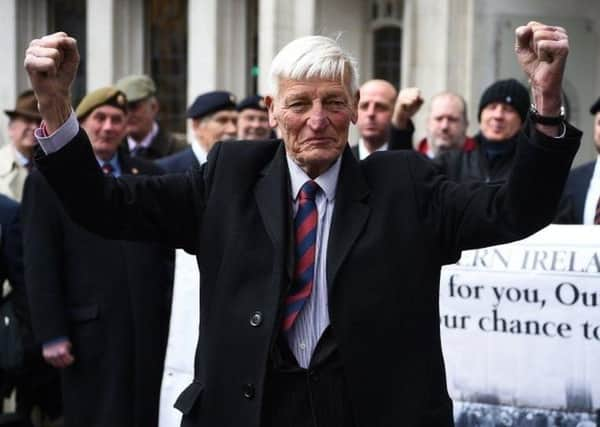The facts: What we know about the case against the late Dennis Hutchings over the 1974 killing of John Pat Cunningham (as set out by the Supreme Court)


The essential details of the case were set out in the UK Supreme Court on June 6, 2019, by Lord Kerr – one of the highest judges in the land.
He was making a ruling dismissing Dennis Hutchings’ efforts to have a jury try his case, rather than a judge hearing it alone (a scenario known as a Diplock trial, which is the default arrangement for most Troubles cases).
In doing so, Lord Kerr set out the following facts:
Advertisement
Hide AdAdvertisement
Hide Ad“On Saturday June 15, 1974, in the late morning, an army patrol consisting of two military vehicles was travelling towards Benburb, Co Tyrone.
“The vehicles contained members of the Life Guards regiment. The lead vehicle had six men on board.
“The commander of the patrol, who was travelling in that vehicle, was Dennis Hutchings...
“As the patrol rounded a left-hand bend near a village called Eglish on what was a winding road, a young man came into view, standing on the left-hand side of the road.
Advertisement
Hide AdAdvertisement
Hide Ad“He appeared to be looking into the hedge at the side of the road. His name was John Paul Cunningham.
“Mr Cunningham appeared startled and confused. He ran across the road in front of the lead vehicle and climbed a gate into a neighbouring field. He then ran towards a metal fence which bordered the field.
“The patrol came to a halt on [Mr Hutchings’] command.
“Most of the soldiers dismounted from the vehicles and took up defensive positions.
“Three members of the patrol, [Mr Hutchings] and two others who have been referred to as B and E, pursued Mr Cunningham.
Advertisement
Hide AdAdvertisement
Hide Ad“Mr Hutchings and soldier E went towards the same gate that Mr Cunningham had climbed over.
“Soldier B went to a gateway further down the road. A number of shouted commands to Mr Cunningham to stop went unheeded.
“It later transpired that he had limited intellectual capacity. His mental age was judged to be between six and 10 years.
“In a report by the Historical Enquiries Team (HET) it was said that he ‘was easily confused and may have had an inherent fear of men in uniform and armoured vehicles’.
Advertisement
Hide AdAdvertisement
Hide Ad“The case made by the prosecution is that when Mr Cunningham failed to stop, shots were discharged by [Mr Hutchings] and the soldier referred to as B.
“Mr Cunningham was hit and died at the scene. At the time that he fell, he was close to the metal fence. It has been established that he was running towards his home.
“The HET concluded after investigation that he was unarmed; that he was shot while running away from the soldiers, and that there was no evidence that he presented a threat to them or to anyone else.”
Mr Hutchings had been unwell with kidney problems for some time, and had also contracted Covid-19.
Advertisement
Hide AdAdvertisement
Hide AdAlongside the trial of Soldier F for alleged crimes committed on Bloody Sunday, Mr Hutchings’ case had stirred the ire of unionist politicians and veterans groups, who pointed to the far greater death toll inflicted by paramilitaries during the Troubles when compared with the Army.
The trial of Soldier F ended with the two murder charges and five attempted murder charges against him being withdrawn in July, over legal wranglings to do with the admissibility of evidence.
Now Mr Hutchings’ trial has collapsed too, due to his death on Monday night in north Belfast’s Mater Hospital.
A group called The Northern Ireland Veterans Movement announced the news online, calling him “our brave friend Regimental Corporal Major Dennis Hutchings”.
Advertisement
Hide AdAdvertisement
Hide AdThe case began back in 2013, when the then-head of the PPS Barra McGrory had requested that the Cunningham killing be reviewed.
Legal action began in April 2015 against Mr Hutchings, who lived in the village of Cawsands outside Plymouth in Cornwall, and who was 74 at the time proceedings got underway.
Seven months later, after the PPS had reviewed the strength of the case, it determined that “there is a reasonable prospect of conviction and that the test for prosecution is met”, and said it would proceed with charges against him.
In the several years of hearings which followed, there was much dispute over whether he should be charged with attempted murder or attempted GBH, or whether charges should be dropped altogether (he could not be charged with outright murder because it was uncertain which soldier had fired the fatal shots).
Advertisement
Hide AdAdvertisement
Hide AdAt the time of his death, Mr Hutchings was charged with – and denied – both offences.
A message from the Editor:
Thank you for reading this story on our website. While I have your attention, I also have an important request to make of you.
With the coronavirus lockdown having a major impact on many of our advertisers - and consequently the revenue we receive - we are more reliant than ever on you taking out a digital subscription.
Advertisement
Hide AdAdvertisement
Hide AdSubscribe to newsletter.co.uk and enjoy unlimited access to the best Northern Ireland and UK news and information online and on our app. With a digital subscription, you can read more than 5 articles, see fewer ads, enjoy faster load times, and get access to exclusive newsletters and content.
Visit www.newsletter.co.uk/subscriptions now to sign up.
Our journalism costs money and we rely on advertising, print and digital revenues to help to support them. By supporting us, we are able to support you in providing trusted, fact-checked content for this website.
Ben Lowry
Editor